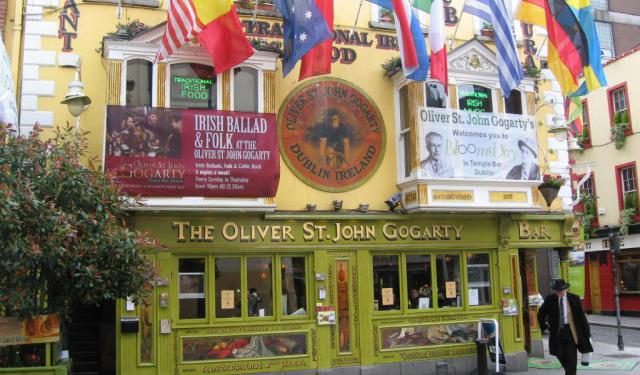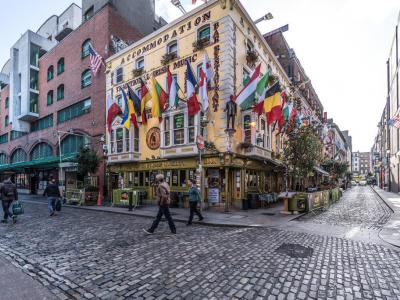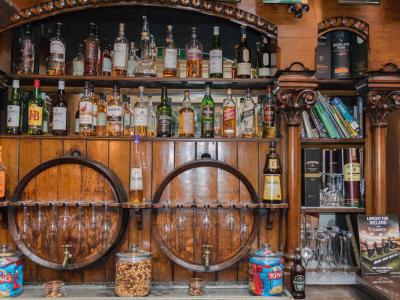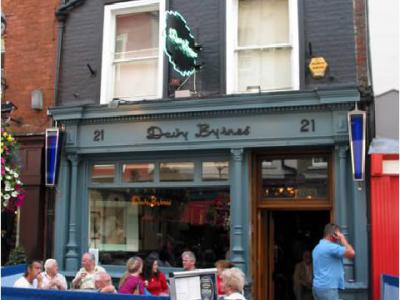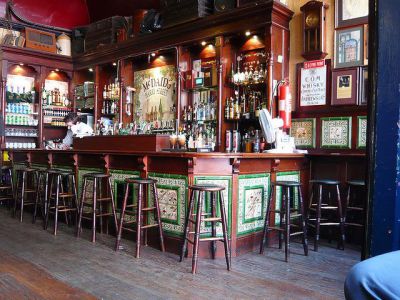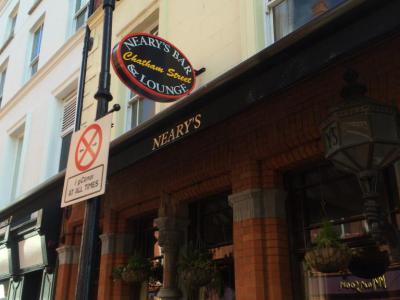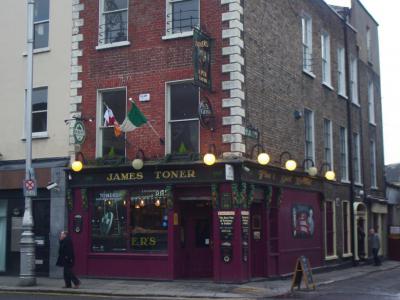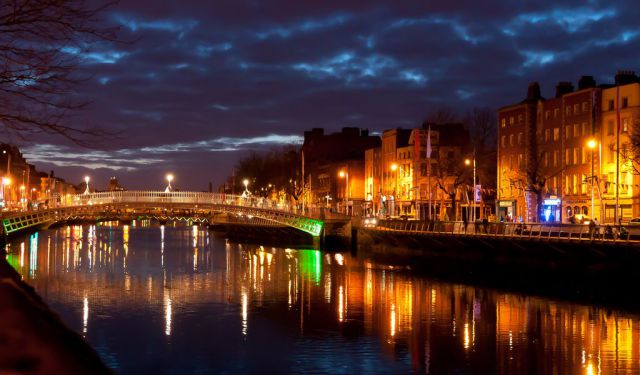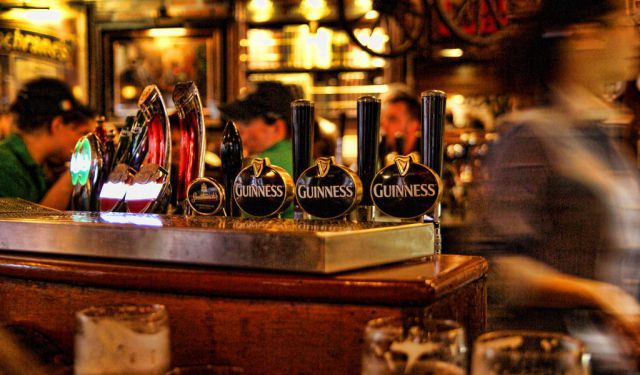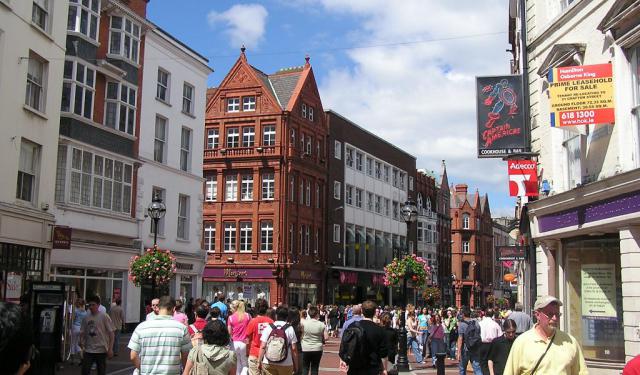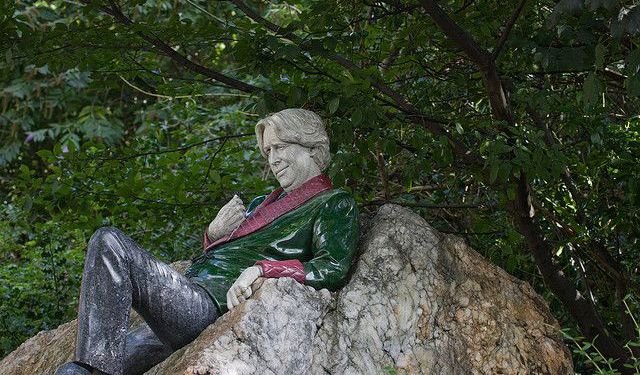Dublin Literary Pubs (Self Guided), Dublin
The three Ps of Dublin – the pub, the poet, and the pint – have always distinguished the Irish capital as home to some of the most literary pubs in Europe. Indeed, Dublin's public houses, where writers traditionally sharpened their wit, today encapsulate the enchantment of the written word and play a significant role in preserving and celebrating this legacy.
Among these revered establishments, Mulligans stands out as an eminent beacon, fostering an atmosphere steeped in literary lore and the spirits of renowned scribes. Established in 1782, the pub was frequented by renowned men of letters such as James Joyce and Brendan Behan. Keep your senses acute and you may still feel their presence.
The Oliver St John Gogarty Pub, named after the prominent Irish poet, playwright, and surgeon of the early 20th century, radiates a captivating ambiance, reminiscent of a bygone era when the luminaries of Irish literature graced its thresholds.
Imbued with the echoes of literary brilliance, The Duke's Pub on Duke Street is a time-honored bastion of creativity and intellectual ferment. A popular haunt for writers and artists since the 19th century, it has had among its patrons over the years the likes of Samuel Beckett and Patrick Kavanagh.
Another enchanting establishment on Duke Street, Davy Byrne's Pub, emerges as a living testament to the wordsmithing prowess of James Joyce. Within its storied walls, one can savor the gastronomic masterpiece immortalized in "Ulysses".
McDaid's, an emblem of literary mystique on Harry Street, has been a gathering place for writers, artists, and intellectuals for generations. Here, the sight of Patrick Kavanagh and Flann O'Brien engaged in lively discussions over pints used to be rather common.
At Toner's Pub on Baggot Street, the connoisseurs of letters, such as William Butler Yeats and Bram Stoker, used to find their respite in an atmosphere of dignified elegance.
Like an artist's palette, the venerable “watering holes” of Dublin, adorned with the weight of words and the fragrance of inspiration, offer a tantalizing fusion of booze and literary discourse to those who seek solace in the harmonious blend of erudition and conviviality. If you're interested in embarking on a transcendental journey through the realms of literature and drink in the Irish capital, take this self-guided pub pilgrimage. Cheers!
Among these revered establishments, Mulligans stands out as an eminent beacon, fostering an atmosphere steeped in literary lore and the spirits of renowned scribes. Established in 1782, the pub was frequented by renowned men of letters such as James Joyce and Brendan Behan. Keep your senses acute and you may still feel their presence.
The Oliver St John Gogarty Pub, named after the prominent Irish poet, playwright, and surgeon of the early 20th century, radiates a captivating ambiance, reminiscent of a bygone era when the luminaries of Irish literature graced its thresholds.
Imbued with the echoes of literary brilliance, The Duke's Pub on Duke Street is a time-honored bastion of creativity and intellectual ferment. A popular haunt for writers and artists since the 19th century, it has had among its patrons over the years the likes of Samuel Beckett and Patrick Kavanagh.
Another enchanting establishment on Duke Street, Davy Byrne's Pub, emerges as a living testament to the wordsmithing prowess of James Joyce. Within its storied walls, one can savor the gastronomic masterpiece immortalized in "Ulysses".
McDaid's, an emblem of literary mystique on Harry Street, has been a gathering place for writers, artists, and intellectuals for generations. Here, the sight of Patrick Kavanagh and Flann O'Brien engaged in lively discussions over pints used to be rather common.
At Toner's Pub on Baggot Street, the connoisseurs of letters, such as William Butler Yeats and Bram Stoker, used to find their respite in an atmosphere of dignified elegance.
Like an artist's palette, the venerable “watering holes” of Dublin, adorned with the weight of words and the fragrance of inspiration, offer a tantalizing fusion of booze and literary discourse to those who seek solace in the harmonious blend of erudition and conviviality. If you're interested in embarking on a transcendental journey through the realms of literature and drink in the Irish capital, take this self-guided pub pilgrimage. Cheers!
How it works: Download the app "GPSmyCity: Walks in 1K+ Cities" from Apple App Store or Google Play Store to your mobile phone or tablet. The app turns your mobile device into a personal tour guide and its built-in GPS navigation functions guide you from one tour stop to next. The app works offline, so no data plan is needed when traveling abroad.
Dublin Literary Pubs Map
Guide Name: Dublin Literary Pubs
Guide Location: Ireland » Dublin (See other walking tours in Dublin)
Guide Type: Self-guided Walking Tour (Sightseeing)
# of Attractions: 7
Tour Duration: 1 Hour(s)
Travel Distance: 2.2 Km or 1.4 Miles
Author: max
Sight(s) Featured in This Guide:
Guide Location: Ireland » Dublin (See other walking tours in Dublin)
Guide Type: Self-guided Walking Tour (Sightseeing)
# of Attractions: 7
Tour Duration: 1 Hour(s)
Travel Distance: 2.2 Km or 1.4 Miles
Author: max
Sight(s) Featured in This Guide:
- John Mulligan's
- Oliver St. John Gogartys
- The Duke Pub
- Davy Byrnes Pub
- McDaids
- Neary's Bar
- Toners Pub
1) John Mulligan's
A cornerstone of Dublin's pub scene, the legendary Mulligan's has been serving patrons since 1782, finding its current home in 1854. Located near the former Theatre Royal on Hawkins Street, its walls are decorated with vintage posters, photos, and showbills dating back to the early 19th century, including a cherished autographed photo of Judy Garland, who graced both the stage and the bar.
Featured briefly in James Joyce's "Counterparts" and a popular filming location, Mulligan's has long been a haunt for journalists, writers, and musicians. A favorite watering hole for staff from publications like the Irish Times and the now-defunct Irish Press, it also attracted Dublin's musical talent, especially with all the music industry offices nearby. Even John F. Kennedy paid a visit in 1945, joining the regulars who have made Mulligan's their second home.
Today, Mulligan's remains a mecca for cultural enthusiasts worldwide, offering a quintessential pub experience and serving top-notch pints. A visit here feels like a pilgrimage to a sacred yet secular sanctuary, where libations are akin to liquid rites.
Featured briefly in James Joyce's "Counterparts" and a popular filming location, Mulligan's has long been a haunt for journalists, writers, and musicians. A favorite watering hole for staff from publications like the Irish Times and the now-defunct Irish Press, it also attracted Dublin's musical talent, especially with all the music industry offices nearby. Even John F. Kennedy paid a visit in 1945, joining the regulars who have made Mulligan's their second home.
Today, Mulligan's remains a mecca for cultural enthusiasts worldwide, offering a quintessential pub experience and serving top-notch pints. A visit here feels like a pilgrimage to a sacred yet secular sanctuary, where libations are akin to liquid rites.
2) Oliver St. John Gogartys
Designed in the charming late 19th-century Irish style, complete with flagstone floors and a healthy dollop of authentic artifacts scattered throughout, this pub is a must-visit on any Dublin itinerary. Named after the Irish poet, playwright, and surgeon who served as a model for a character in Joyce's "Ulysses", it sits in the heart of the Cultural Quarter, Temple Bar, offering a touristy yet authentic experience.
Once a favored haunt of literary luminaries like James Joyce, Samuel Beckett, and Brendan Behan, the pub pays homage to its storied past with due reverence. A cultural powerhouse by association, it also doubles as an excellent dining and entertainment venue. Traditional Irish music sets the tone upstairs in the afternoons, while contemporary hits play on the ground level. With both indoor and outdoor seating, it's one of the few spots where you can grab a bite late into the night, all while soaking in the lively ambiance.
Once a favored haunt of literary luminaries like James Joyce, Samuel Beckett, and Brendan Behan, the pub pays homage to its storied past with due reverence. A cultural powerhouse by association, it also doubles as an excellent dining and entertainment venue. Traditional Irish music sets the tone upstairs in the afternoons, while contemporary hits play on the ground level. With both indoor and outdoor seating, it's one of the few spots where you can grab a bite late into the night, all while soaking in the lively ambiance.
3) The Duke Pub
Ideally placed in the heart of Dublin, on historic Duke Street, this venerable establishment has been serving Dubliners liquid refreshments and hearty fare since 1822. Having undergone a lavish Victorian makeover in the 1890s, its facade remains virtually unchanged to this day.
With its prime location amidst the city's commercial and literary life, The Duke has long been a favorite haunt of Ireland's literary elite. Figures like James Stephens, James Joyce, Oliver Gogarty, and Arthur Griffith were among its esteemed patrons in the early 20th century.
In later years, the pub witnessed the sporadic patronage of three literary giants-Brendan Behan, Patrick Kavanagh, and Flann O'Brien-though rarely all at once, given their less-than-affectionate relationships. Typically, the presence of one implied the absence of the others.
Step inside to discover a warm, softly lit interior that beckons with a cozy ambiance, ideal for savoring a pint of Guinness or a traditional Irish whiskey. The menu features classic Irish pub fare, including hearty stews and perfectly battered fish and chips, albeit at slightly higher prices that are justified by generous portions and top-notch quality.
Don't miss the live traditional Irish music performances or the outdoor seating area, offering prime spots for people-watching.
With its prime location amidst the city's commercial and literary life, The Duke has long been a favorite haunt of Ireland's literary elite. Figures like James Stephens, James Joyce, Oliver Gogarty, and Arthur Griffith were among its esteemed patrons in the early 20th century.
In later years, the pub witnessed the sporadic patronage of three literary giants-Brendan Behan, Patrick Kavanagh, and Flann O'Brien-though rarely all at once, given their less-than-affectionate relationships. Typically, the presence of one implied the absence of the others.
Step inside to discover a warm, softly lit interior that beckons with a cozy ambiance, ideal for savoring a pint of Guinness or a traditional Irish whiskey. The menu features classic Irish pub fare, including hearty stews and perfectly battered fish and chips, albeit at slightly higher prices that are justified by generous portions and top-notch quality.
Don't miss the live traditional Irish music performances or the outdoor seating area, offering prime spots for people-watching.
4) Davy Byrnes Pub
Davy Byrne's pub gained fame for its cameo in Chapter 8 ('Lestrygonians') of James Joyce's 1922 modernist novel "Ulysses", set on Thursday, June 16, 1904. In the novel, the protagonist Leopold Bloom, an advertising canvasser, pauses just before 2 PM to enjoy a gorgonzola cheese sandwich with mustard and a glass of burgundy while wandering through Dublin.
Since then, the pub has become a pilgrimage point for fans of Joyce's work, who, like Bloom, stop by to savor a cheese sandwich and a glass of wine. It's especially popular on Bloomsday, an annual celebration held on June 16th in honor of both the book and James Joyce himself. Additionall references are made in Joyce's short story "Counterparts" in Dubliners, where the pub serves as a setting for the protagonist, Farrington, following an altercation at the office, as well as in "Green Rushes", a collection of short stories by Maurice Walsh.
Stepping inside, you'll find vintage charm tastefully blending two bars and numerous tables with beautiful wallpaper and chandeliers. It's a favorite spot among locals, who not only come to dine but also to catch up on the news over a meal. Don't miss out on their burgers – widely regarded as some of the best in the city. In fact, everything on the menu is delightful, and the service is top-notch. While live music sets the ambiance in the front, the back room offers a quieter setting for those seeking a more relaxed experience.
Since then, the pub has become a pilgrimage point for fans of Joyce's work, who, like Bloom, stop by to savor a cheese sandwich and a glass of wine. It's especially popular on Bloomsday, an annual celebration held on June 16th in honor of both the book and James Joyce himself. Additionall references are made in Joyce's short story "Counterparts" in Dubliners, where the pub serves as a setting for the protagonist, Farrington, following an altercation at the office, as well as in "Green Rushes", a collection of short stories by Maurice Walsh.
Stepping inside, you'll find vintage charm tastefully blending two bars and numerous tables with beautiful wallpaper and chandeliers. It's a favorite spot among locals, who not only come to dine but also to catch up on the news over a meal. Don't miss out on their burgers – widely regarded as some of the best in the city. In fact, everything on the menu is delightful, and the service is top-notch. While live music sets the ambiance in the front, the back room offers a quieter setting for those seeking a more relaxed experience.
5) McDaids
This classic Irish pub on Harry Street was the one time haunt for the nation's 20th-century literary giants: Patrick Kavanagh, Flann O'Brien, J.P. Donleavy, Liam O'Flaherty, Paddy Kavanagh and Brendan Behan. The latter, in particular, was a regular and often entertained the crowd with his vast repertoire. He is also said to have based some of his characters in "The Hostage" and "Borstal Boy" on the publicans he met here. According to Joycean scholars, McDaids also served as the setting for the opening of his story, "Grace".
The place has quite a unique ambiance, with a distinctive Victorian exterior and dimly lit interior, featuring high ceilings and a smattering of chairs and tables. Upon stepping inside, you may find it hard to believe that it was once the City Morgue, later turned into a chapel for the Moravian Brethren, hence the Gothic-style windows and lofty ceilings.
Today, McDaids is known for its jazz and blues music sessions, adding to its cultural allure steeped in literary history. Conveniently located near Grafton Street, it's a perfect retreat after a shopping spree, offering a comforting pint of Guinness, fondly called "plain". Otherwise, if you're planning a party, the room upstairs is just the ticket. Despite being packed on weekends like many popular Irish pubs, this doesn't deter those seeking to immerse themselves in the atmosphere of old literary Dublin.
The place has quite a unique ambiance, with a distinctive Victorian exterior and dimly lit interior, featuring high ceilings and a smattering of chairs and tables. Upon stepping inside, you may find it hard to believe that it was once the City Morgue, later turned into a chapel for the Moravian Brethren, hence the Gothic-style windows and lofty ceilings.
Today, McDaids is known for its jazz and blues music sessions, adding to its cultural allure steeped in literary history. Conveniently located near Grafton Street, it's a perfect retreat after a shopping spree, offering a comforting pint of Guinness, fondly called "plain". Otherwise, if you're planning a party, the room upstairs is just the ticket. Despite being packed on weekends like many popular Irish pubs, this doesn't deter those seeking to immerse themselves in the atmosphere of old literary Dublin.
6) Neary's Bar
Just a stone's throw away from Trinity College and Saint Stephen's Green, Neary's holds the prestigious title of UNESCO City of Literature Bar, thanks to its deep connections to the performing arts and literary scene. Its back entrance faces the stage door of the Gaiety Theatre, making it a favorite haunt for actors and writers alike. One notable regular was Brendan Behan, who spent many a night here in the 1950s.
Established in 1887, Neary's embodies classic Edwardian style, boasting a fine brick exterior and cast iron lamps at the main door. Stepping inside feels like entering a cozy time capsule, with no radio or TV in sight to distract from the ambiance. Plush crimson curtains offer privacy, while antique lampshades, including working gas lamps, adorn the space. The bar features a grand marble counter, often hosting patrons dressed in three-piece suits, complete with hats and scarves. Even the barkeeps sport crisp white shirts and black bow ties.
While Neary's serves a stellar pint of Guinness, it's considered a splurge due to its upscale pricing. Despite its allure, budget-conscious patrons may find it more of a special occasion spot than a regular haunt for casual dining.
Established in 1887, Neary's embodies classic Edwardian style, boasting a fine brick exterior and cast iron lamps at the main door. Stepping inside feels like entering a cozy time capsule, with no radio or TV in sight to distract from the ambiance. Plush crimson curtains offer privacy, while antique lampshades, including working gas lamps, adorn the space. The bar features a grand marble counter, often hosting patrons dressed in three-piece suits, complete with hats and scarves. Even the barkeeps sport crisp white shirts and black bow ties.
While Neary's serves a stellar pint of Guinness, it's considered a splurge due to its upscale pricing. Despite its allure, budget-conscious patrons may find it more of a special occasion spot than a regular haunt for casual dining.
7) Toners Pub
Toners, one of Dublin's oldest and most renowned traditional pubs, is celebrated not only for its superb pints of Guinness in the large beer garden but also for its strong literary ties. Back in the day, this place was famed as a haunt of James Joyce and Patrick Kavanagh, whose faces now stare down from the pub's sign. Even William Butler Yeats, not typically one for pub culture, made occasional visits out of sheer curiosity, while Bram Stoker was drawn to the unique atmosphere and spent considerable time here.
Step inside and prepare to be whisked away to a bygone era, where the bar taps flow like the River Liffey and the flagstone floors are older than your great-grandma's tales of leprechauns. From the antique stock drawers to the whimsical curiosities in the cabinets, it's like stumbling into your eccentric great aunt's attic – but with better drinks.
With its outdoor yard expansion, Toners has become the ultimate urban oasis – perfect for a quiet pint, a rowdy night out, or just soaking up some rays with a cold one in hand. So grab your sense of adventure and let's raise a glass to the pub that's older than time itself!
Step inside and prepare to be whisked away to a bygone era, where the bar taps flow like the River Liffey and the flagstone floors are older than your great-grandma's tales of leprechauns. From the antique stock drawers to the whimsical curiosities in the cabinets, it's like stumbling into your eccentric great aunt's attic – but with better drinks.
With its outdoor yard expansion, Toners has become the ultimate urban oasis – perfect for a quiet pint, a rowdy night out, or just soaking up some rays with a cold one in hand. So grab your sense of adventure and let's raise a glass to the pub that's older than time itself!
Walking Tours in Dublin, Ireland
Create Your Own Walk in Dublin
Creating your own self-guided walk in Dublin is easy and fun. Choose the city attractions that you want to see and a walk route map will be created just for you. You can even set your hotel as the start point of the walk.
A Walk Along Liffey River
The River Liffey - Dublin’s liquid backbone - slices through the Irish capital like a great shimmering bookmark, separating the Northside from the Southside in a civil yet longstanding sibling rivalry. Stretching around 125 kilometers, this body of water is indeed a living archive, a story that never quite ends. Stroll along its banks, and you’ll find yourself time-traveling without the hassle... view more
Tour Duration: 1 Hour(s)
Travel Distance: 2.1 Km or 1.3 Miles
Tour Duration: 1 Hour(s)
Travel Distance: 2.1 Km or 1.3 Miles
Pub Crawl
The Irish in general and Dubliners in particular are known for their passion for whiskey and beer. As you embark upon a beguiling odyssey through the spirited streets of the Irish capital, you can't help noticing the reverberating vibrancy coming from its enchanting pubs. A tapestry of libation-laden lore awaits those who traverse the path of the Dublin pub crawl, guided by the siren call of... view more
Tour Duration: 2 Hour(s)
Travel Distance: 2.4 Km or 1.5 Miles
Tour Duration: 2 Hour(s)
Travel Distance: 2.4 Km or 1.5 Miles
Dublin Introduction Walking Tour
The Irish capital, Dublin, is a city where history has a pint in one hand and a smartphone in the other. Sitting snugly on Ireland’s east coast, straddling the River Liffey like it owns the place, Dublin is a heady mix of medieval charm, Georgian swagger, and modern-day buzz. The name itself, Dubh Linn (the Celtic expression for “black pool”) sounds mysterious enough - and yes, it refers to... view more
Tour Duration: 2 Hour(s)
Travel Distance: 3.8 Km or 2.4 Miles
Tour Duration: 2 Hour(s)
Travel Distance: 3.8 Km or 2.4 Miles
A Walk with Famous Irish Writers
Albeit a small country, Ireland has given the world a plethora of remarkable writers and poets, many of whom were born, lived, and studied in Dublin. Needless to say, as an epicenter of Ireland's literary scene, Dublin boasts a myriad of hallowed locations closely associated with the luminaries of Irish literature, such as James Joyce, William Butler Yeats, Samuel Beckett, and many of their... view more
Tour Duration: 2 Hour(s)
Travel Distance: 4.5 Km or 2.8 Miles
Tour Duration: 2 Hour(s)
Travel Distance: 4.5 Km or 2.8 Miles
Useful Travel Guides for Planning Your Trip
16 Distinctively Irish Things to Buy in Dublin
The birthplace of many artistic talents, such as Jonathan Swift and Oscar Wilde, Dublin is the show-window of Ireland, a small country renowned for its rich cultural scene encompassing music, writing, poetry, dance, craftsmanship and more. The food & drink scene of Dublin (much as the whole of...
The Most Popular Cities
/ view all
